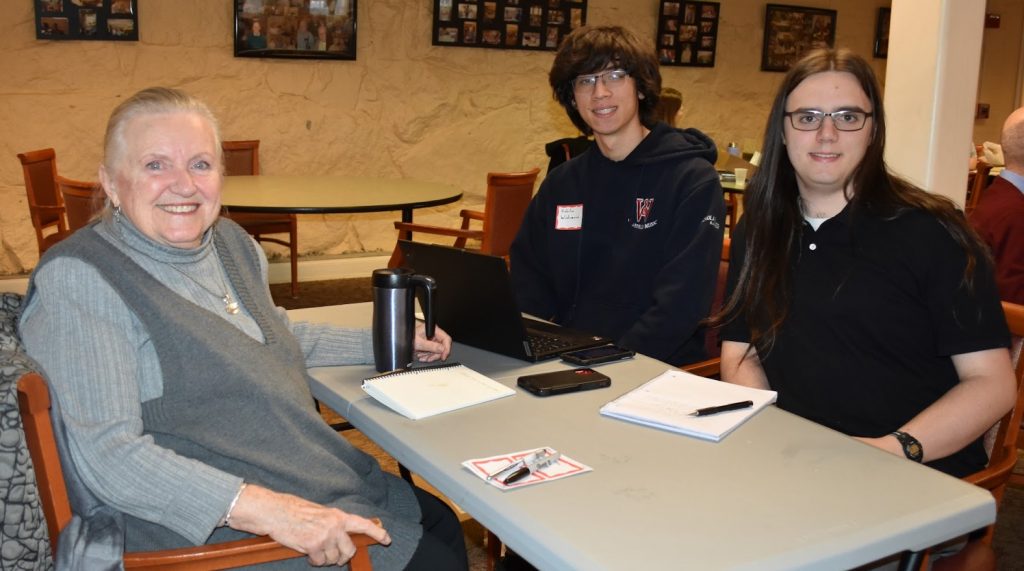By Nicholas Wedemeier & Liam Mertens
This spring, local Wakefield seniors and Wakefield Memorial High School seniors came together for lunch, conversation, and interviews as part of a cross-generational program called Seniors to Seniors. The resulting articles written by journalism students are being published as a series. Seniors to Seniors is a collaboration between Wakefield Memorial High School, The Savings Bank, JC Marketing Associates, The Room to Write, The Wakefield Daily Item, and the Wakefield Senior Center.
With such a varied life, it is a stalwart challenge to find what defines Cheryl Webb Scott. In fact, it would be unsurprising to read “milliner” given how many hats she’s worn through her long and storied career (oftentimes literally). Even still, what would be a normal life experience to her would be remarkable to most any other person, even in her childhood.
Born July 19, 1942, to parents Mildred McCool & Donald W. Webb, Cheryl’s formative years are remarkable by any stretch imaginable. Cheryl describes her father as “a practical man” who taught her many useful skills in rather unorthodox methods and fields. To this point, Cheryl told us that when she was young, her father would take her to his business meetings and have her sit in on them. The purpose of this was to teach her how to listen and formulate specific questions that would help her learn more.
Cheryl’s odd childhood continues through high school, being vastly different from the one familiar to Wakefield. Though she found her high school enjoyable and safe, Cheryl describes a tactic of her school, that instead of letting fights break out in the halls, the school would organize them in dedicated outdoor areas with rules and let people watch. She said that this showed students the scary reality of the real world and the futility of fighting while keeping the school safe. Despite her tumultuous surroundings, her love of learning and willingness to help teach others made these years especially memorable for her. One of her favorite memorable moments was during the introduction of international families. The sense of community that was fostered by introducing new cultures as a positive remains a bright spot in her life, even decades later.
After graduating high school, Cheryl went on to study at the University of Michigan. The loss of her father and the pressures of college made her first year especially tough. Eventually, Cheryl recouped and eventually met Peter, an architecture student with whom she shared many classes. The two of them started dating and would eventually get married after they graduated. After completing a bachelor’s degree in Design, Interior Design, Sociology, and Education at the University of Michigan, she was offered the position of dorm mother of the brand-new co-ed dorm at the University. The kicker? She was offered the ability to take as many classes as she would like for free. “It was like falling into a tub of chocolate. When that ended, I went back to Detroit, where I got the most fabulous job I could have imagined.” After taking more classes while working as the dorm mother, she moved to work in a design firm run by a “remarkable Russian woman” named Milka Iconomof whom she described as “tough as nails.” Cheryl told us that even though most people at the firm were scared of the boss, she was not. Eventually, her boss would take her under her wing and teach Cheryl techniques in the craft that allowed her to advance her career and become “very knowledgeable and very secure as a result of [Milka’s] help.”
Soon, however, her life was put on hold because of the Vietnam War. Peter opted to join the Navy instead of being drafted into the Army. This left Cheryl alone in Detroit in 1967 while riots were happening all around her. Instead of being scared, she squared her shoulders and kept on going. She knew of the violence and destruction, and it was hard not to, especially since rioting was happening houses away. From how she describes it, it was like she was living in a warzone.
When she decided to join her husband in Norfolk Virginia, the Navy notified her they would send a marine escort to take her to the airport. Three days before she was set to be extricated, she was alone and running out of food, so she decided to order a pizza. When the pizza boy arrived, he was disheveled; it seemed like he had gone through hell. When she asked for his story, he told her that the rioters had flipped his pizza truckand he had to walk the rest of the way. She did the only thing she could think to do: take him in and wait for the Marines to get both of them. Luckily, the Marines that were sent to get her were more than willing to return the boy to his grateful mother and get Cheryl unharmed on a plane out of Detroit. She started in Norfolk, VA, and from there she moved to Baltimore, MD, where she stayed for some time while her husband’s ship was being refitted. Finally they moved to Newport Naval Station in Rhode Island, where she expected to settle down. This dream was quickly cut short as just four days after arriving, Peter’s ship was deployed for a six-month assignment.
In Rhode Island, she learned that the Navy had an incredibly condescending attitude toward the sailors’ wives and found them to be an unnecessary liability. Cheryl even recalls the Navy giving her a book that started with “Ladies, keep in mind, if the Navy had wanted your husband to have a wife, we would have assigned him one.” This attitude towards women lit a flame in her heart, so she took to protesting the injustices that women faced in the world. Accordingly, Cheryl started joining marches for women’s rights in Providence while her husband was still deployed. However, she had to keep her involvement a secret from the Navy because if they found out, they might punish her husband. As a result, she couldn’t tell the other wives where she was going.
In addition to this sexist attitude, the Navy did not pay anyone nearly enough to live on. As a result, she needed to supplement her income, so she started making and selling assorted goods, including custom clothes, furniture, and plaques. She wasn’t alone in this; most of the Navy wives ended up doing similar things just to stay afloat, creating a sub-community on the government base.
Her involvement with the other Navy wives led to Cheryl joining a bridge club on the base. The buy-in was $5, and the top few places won prizes. What the other wives didn’t know, however, was that Cheryl had “[grown] up playing bridge with [her] parents, [who were] serious bridge players.” She would go to the bridge club every Tuesday and walk away with more money than she started with, and soon this became the primary way she funded herself. Cheryl looks back on this now and says, “There’s always some skill you have that you don’t think much of [and] you’re not expected to know [that] can get you through those hard times. I look back at them as really good times because I learned a lot, and I survived.” The bridge club was Cheryl’s escape from real life and not only allowed her to earn more money, but also taught her the importance of having skills you can rely on.
After the Navy the Scotts lived in Boston for some time. Cheryl wanted to leave the city and buy a Victorian house. She eventually found one in Wakefield, and it was love at first sight. She brought her husband to see it, and even though he thought it would be a lot of upkeep, theyagreed to buy it, and so they moved to the “burbs” in 1970.
During her first two decades in Wakefield, Cheryl became a mother, worked as a freelance interior designer and was very active in the PTO and other volunteer organizations. She co-founded the Wakefield Center Neighborhood Association (Rockery renovation; holiday lights on the Common; the Easter Egg Hunt; the Spaulding Street Playground and more); served for years on the Board of the Americal Civic Center andwas WCAT’s announcer for the 4th ofJulyparade. In 1989 she and her husband were celebrated as the Citizens of the Year by the West Side Social Club.
By 1989 Cheryl also started hosting many programs produced at WCAT. She also created ‘The Total Women’ a public access television show about women’s issues. That program continues today with over 420 episodes produced at WCAT in Wakefield and SCA in Stoneham.
In 1994 Cheryl and her husband Peter founded Scott & Scott, an architecture and interiordesign firm, out of their house. They worked together for 25years, designing projects throughout the Eastern United States.
Currently, Cheryl is still out, about, and busy as ever. She occupies her time by renovating her home, continuing her feminist work, hosting The Total Woman, and socializing in Wakefield. With all of this, she speaks fondly of her Wakefield life, expressing great joy at her accomplishments, having hosted her TV show, run a local business, and been an active member of the community. Above all, she is immensely proud of her son Christopher, an IT director for a cyber security company, and daughter Cydney, a senior photographer at Boston University and president of the University Photographers Association of America.




